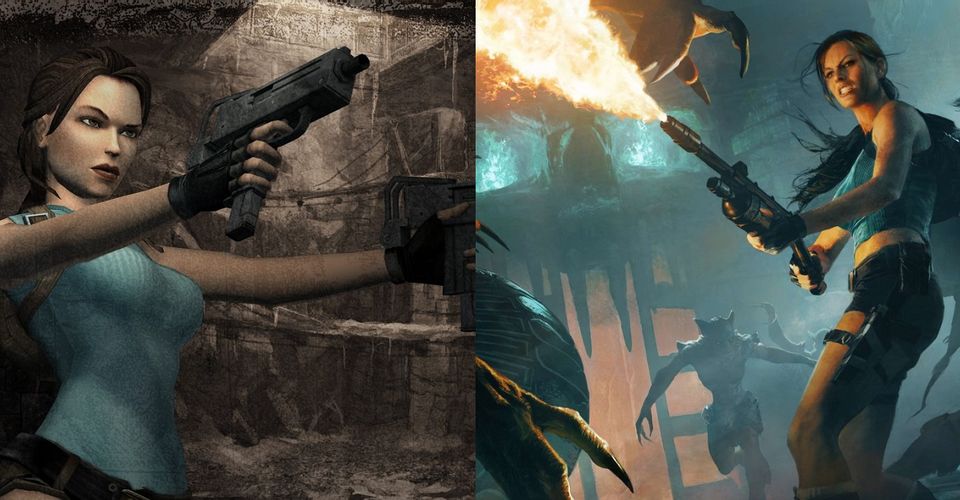The 13 Best Tomb Raider Games, Ranked According To Metacritic

Over the past 25 years, Lara Croft has become one of the most popular fictional characters in video games and cinematic lore. First introduced in 1996 by Core Design and Eidos Interactive, the character has appeared in 17 main Tomb Raider games, several spinoff games, and three feature films to date.
Of course, the Tomb Raider gaming franchise has undergone a marked evolution since debuting in 1996. As technology has advanced greatly over the past quarter-century, so too has the various iterations of the games, as well as the evolution of the Lara Croft character itself.
Updated on September 15th, 2021 by Kevin Pantoja: With a gaming franchise as popular and extensive as this one, it’s good to dive as deep as possible. That means scouring more than just ten entries to find the best Tomb Raider game. These games span various platforms, from technological marvels to handheld devices, but all keep the spirit of what makes Tomb Raider so special as a franchise and what makes Lara Croft such an iconic character. Having the Tomb Raider games ranked will allow newcomers to the franchise to understand which installments need to be played and which ones can actually be skipped.
13 Tomb Raider: Chronicles (2000) – 59/100

By this point in the franchise, things were starting to run thin. The best Tomb Raider games were seen to be in the rearview mirror as ideas were thinner and there wasn’t much of an advance technologically since these were still being released on the original PlayStation system.
Following the events of the previous installment, Tomb Raider: The Last Revelation, Lara was presumed dead. That meant her missions had to have more of a stealth vibe to them, possibly to take advantage of the popularity of Metal Gear Solid around that time. Alas, reviews of this entry were mixed but a movie was coming soon to boost popularity again.
12 Tomb Raider: The Prophecy (2002) – 66/100

It often feels like people forget about the quality games that came out for the Game Boy Color and Game Boy Advance platforms. While they weren’t the most impressive from a graphics perspective, they did as much as they could with the limitations of the console and that’s the case with this 2002 release.
Tomb Raider: The Prophecy looked about as good as it possibly could and opted for an isometric layout, which felt different from previous portable installments. The main criticisms came from a basic story and somewhat repetitive gameplay mechanics that gamers grew tired of pretty quickly.
11 Tomb Raider III (1998) – 76/100

When Tomb Raider III arrived, it was clear that this series was a juggernaut in terms of sheer popularity. Many consider the first entry groundbreaking and the second to be among the best PS1 games, so the third was highly anticipated and had a lot to live up to.
Thankfully, it succeeded in many ways including some gorgeous locations, a few new abilities for Lara, and by going back to more puzzle-solving like the first game. The biggest gripe with this version was that you got the sense the formula was starting to get stale, causing some fans to head elsewhere for something different.
10 Tomb Raider: Underworld (2008) – 80/100

Continuing events from Tomb Raider: Legend, Underworld is the 12th main game in the series. The story follows Lara after her mansion burns down and she attempts to find Avalon, a legendary island that may hold answers to her long-lost mother’s whereabouts.
Displayed in third-person perspective, a post-mission following the main game called Beneath the Ashes is included, in which Lara is tasked with finding an artifact in her father’s hidden study. Once activating the object, Lara must defeat her evil doppelgänger. Though clearly a strong game, some fans thought it was the worst of the Legend series.
9 Tomb Raider: Legend (2006) – 82/100

With eight challenging levels set over seven global locales, Tomb Raider: Legend harnessed the most popular elements of the game series successfully, while upgrading Lara herself with an expressive and responsive new design. The story of the game begins with Lara’s pilgrimage to Bolivia, where she is to find a lost stone relic that may have something to do with the mysterious disappearance of her mother.
With several flashbacks to her childhood, Lara then sets out to obtain a priceless sword while fighting her old colleague, Amanda, who’s been long thought dead. Lara’s sojourn takes her to Peru, Tokyo, Cornwall, Kazakhstan, Nepal, and back to her native England.
8 Shadow Of The Tomb Raider (2018) – 82/100

The most recent game in the franchise to be released includes Shadow of the Tomb Raider, set two months after the events of Rise of the Tomb Raider. The story finds Lara Croft and her friend Jonah in Mexico to fight The Trinity, a nefarious sect with links to the Mayan apocalypse.
When Lara steals the sacred Dagger of Chak Chel from a hidden Trinty burial site, she accidentally triggers the apocalypse. To reverse the curse, Lara and Jonah traverse the ruins of South America in search of a Box that can channel the powers of the god Kukulkan. The game flew under the radar for many fans, but its high critical score alone indicates that it’s more than deserving of a second chance.
7 Lara Croft Go (2015) – 84/100

The lone Tomb Raider spinoff game with a high Metacritic includes the 2015 release of Laura Croft Go, a puzzle game in which players control Lara Croft across a gameboard while sidestepping roadblocks and defeating enemies. There are 40 levels and five chapters.
Modeled after Hitman Go, the game increases mobility by allowing Lara to move on the board both vertically and horizontally. When players aren’t avoiding boobytraps and boulders, they must defeat deadly spiders, snakes, lizards, and the like, giving it enough variation for a very high critical score in the franchise’s history.
6 Tomb Raider Anniversary (2007) – 83/100

As an upgraded remake of the original 1996 Tomb Raider game, Anniversary takes place before the events in Tomb Raider: Legend. Designed by Crystal Dynamics, the story traces Lara’s dogged quest to find the Scion of the lost city of Atlantis.
With 14 levels taking place in four distinct global locations, the reboot pays homage to the original while pushing the efficacy of the gameplay forward. The game drew its biggest praise for the PC and PS2 versions, namely for its expansion of original levels and use of fewer tutorials. It was a great choice to release a new version of a classic following the success of Legend.
5 Lara Croft And The Guardian Of Light (2010) – 85/100

In addition to nixing the Tomb Raider namesake from its title, Lara Croft and The Guardian of Light reshaped the entire mode of gameplay the franchise is known for. Rather than a linear adventure game with a virtual camera, the game features an arcade-style game with a static camera. It’s also the first game in the series to offer multiplayer mode.
When it comes to a story, the game finds Lara in search of an ancient mirror of smoke that has imprisoned the Keeper of Darkness, Xolotl, for 2,000 years. When mercenaries steal the mirror and unleash Xolotl and its evil minions, Lara has until dawn to defeat her foes. Reviews found this game to be a fresh take on a series that needed it.
4 Tomb Raider II (1997) – 85/100

Tomb Raider II revolves around Lara’s search for the Dagger of Xian, a mystical relic that, when plunged into the heart of its carrier, can turn them into an almighty dragon. The game drew its highest ratings for its PlayStation release.
This iteration took things to the next level as Lara visited places like the Great Wall of China and Venice. It was also known for being more action-driven than its predecessor and being among the hardest games in the franchise. However, players liked the challenge and the daring places this game went.
3 Tomb Raider (2013) – 87/100

As the tenth title in the series, the 2013 release of Tomb Raider serves as a rebooted makeover of the franchise that also explores Lara Croft’s origin story. With advanced gameplay and a multiplayer mode, the story takes place on a fictional lost island of Yamatai off the coast of Japan.
Lara’s main mission in the game is to locate the hidden kingdom and confront the Sun Queen, a supernatural deity who is believed to have the power to control the weather. In addition to its revamped and upgraded gameplay, the game was praised for Camilla Luddington’s voice acting as Lara.
2 Rise Of The Tomb Raider (2015) – 88/100

With an increased emphasis on gameplay combat, Rise of the Tomb Raider is the second-highest-rated game in the franchise to date, per Metacritic. As Lara sets out to find the lost city of Kitezh beneath Russia, she employs an impressive arsenal of weaponry to complete the task.
The game drew widespread acclaim for its gorgeous graphics, immersive atmosphere, and intricate environments. Camilla Luddington reprised her role as Lara, spending two years filming motion-capture sequences for the game as an added boost.
1 Tomb Raider (1996) – 91/100

According to Metacritic, the original Tomb Raider game still ranks the highest. First released on the Sega Saturn before becoming available for MS-DOS and PlayStation, the game launched the highly successful 25-year gaming franchise.
Drawing inspiration from Indiana Jones, the plot follows globetrotting British archaeologist Lara Croft as she sets out to find the Scion of Atlantis. The game drew instant buzz for its game-changing graphics, dexterous controls, revolutionary environments, and engaging puzzle solving.
















